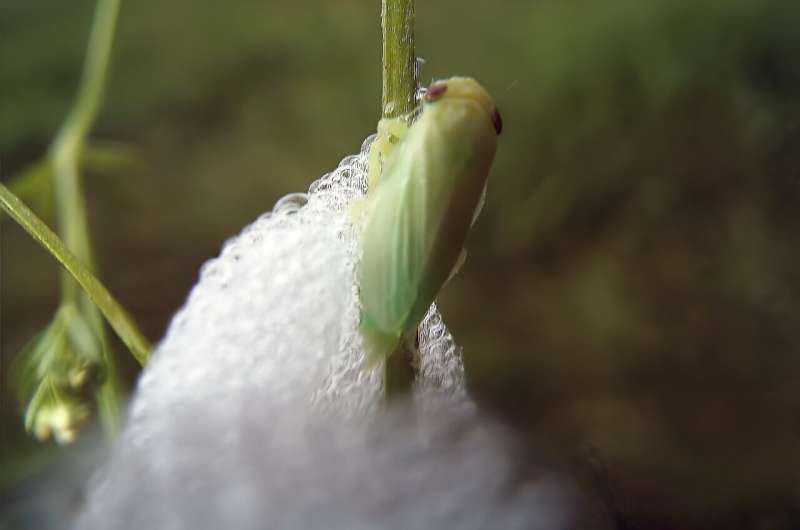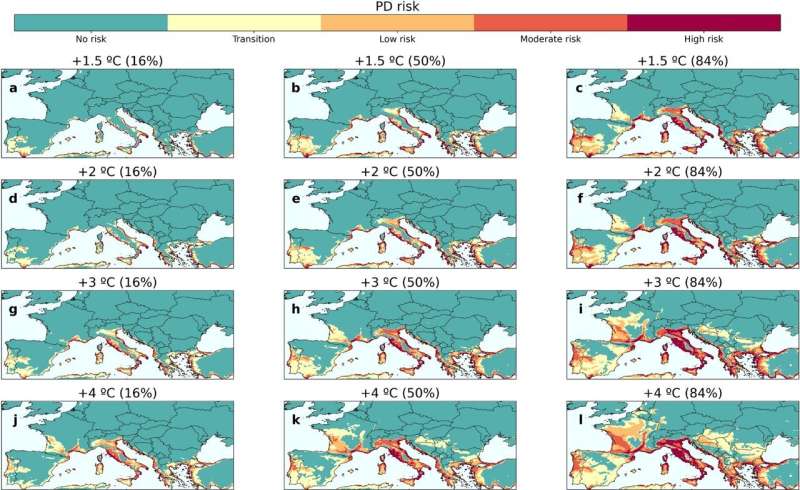This article has been reviewed according to Science X's editorial process and policies. Editors have highlighted the following attributes while ensuring the content's credibility:
fact-checked
peer-reviewed publication
trusted source
proofread
Study shows climate change boosts olive tree-devouring bacteria in the Mediterranean

Xylella fastidiosa, the deadly disease-causing bacterium that has already wiped out millions of plants of emblematic Mediterranean crops, like grapevines, olive-trees and almond-trees, by clogging their ducts and plant tissues, will get a boost from climate change in relevant wine-producing regions where the risk is low at present.
Researchers at the Institute of Cross-disciplinary Physics and Complex Systems (IFISC), a joint center of the Spanish National Research Council (CSIC) and the University of the Balearic Islands (UIB), have developed a new technique to characterize the risk of establishment of Pierce's Disease, and using state-of-the-art climatic data, have obtained predictions about the future expansion of the disease under different scenarios posed by global warming. Researchers from the Institute of Physics of Cantabria (IFCA), a joint center of the CSIC and the University of Cantabria, have collaborated in the work.
These findings, published in a study in the journal Scientific Reports, describe how an increase of more than 3 degrees in the planet's average temperature compared to preindustrial levels would be a "turning point in the risk" of establishment of the bacterium, which at present affects crops in coastal Mediterranean areas, spreading further north in Europe.
Climate determines the area in which these diseases can occur, hence a favorable temperature enhances the development of epidemic outbreaks. The scientist Manuel Matías, from IFISC-CSIC-UIB and author of this research, considers climate change to be a key factor in the "impulse and distribution of diseases in plants around the world."
The team led by Matías has delimited the contagious effect of X. fastidiosa in four different stages of continued growth of temperatures that are predicted for the coming years: an increase of 1.5, 2, 3 and up to 4 degrees, compared to pre-industrial levels. The pattern of increased risk of establishment of the disease due to temperature increase is repeated in all scenarios.
A global epidemic with millions of losses
A decade has just passed since the first detection of the X. fastidiosa bacterium in Europe, which until the 21st century was officially considered a pathogen restricted only to the American continent. In California (United States), this bacterium causes the lethal Pierce's disease in grapevines, generating millions of dollars in losses in the wine sector every year. Infected plants produce few fruits of poor quality, their leaves discolor, necrotize and fall off, and the plants can die within a few years, especially if they are not watered, which is the rule in many Mediterranean areas.
For the European outbreaks analyzed, spittlebugs, belonging to the Aphrophoridae family, specifically the meadow spittlebug, Philaenus spumarius, are considered to be the main vector. The rapid spread of the disease has already led to the destruction of crops in Italy (21 million olive-trees in the Apulia region), and is also to blame for the uprooting of thousands of almond trees in the Balearic Islands (in Mallorca alone it is estimated to have affected 80% of almond-trees) and several districts in Alicante province.

The research, which can be consulted here, shows how the prolonged rise in temperatures is expanding the distribution of X. fastidiosa further North from the originally affected areas close to the Mediterranean, with France, Italy and Portugal being the most affected countries. The study also points to a decline of the insect P. spumarius, although marginal in some areas, such as a large part of Spain, which would slightly increase its ecological niche in the more continental or mountainous areas of Europe.
Researchers consider climate change to be one of the biggest challenges for EU agricultural policy. They argue that forecasting what could happen in certain regions will help to make better decisions in the future, increasing the level of surveillance in these areas, reducing the possible impact of the disease on crops.
For this reason, scientists have quantified the risk of X. fastidiosa infection at different spatial scales; at the level of country, appellation and known wine plantations. Based on an analysis of the area at risk per country, the scientists have collated how, in an initial scenario projecting a temperature increase of 1.5 degrees Celsius, Portugal and Greece face the highest risk of infection, with 12% and 2% more, respectively.
A scenario that, at an additional 4 degrees, would rise to a "staggering" risk, they admit, of 47% and 63%. The authors describe how in this scenario France and Italy would also experience a "relevant" risk, albeit lower. In the case of Spain, the second largest wine producer, they clarify that the risk would remain similar to current levels.
A situation that contrasts with some areas with designation of origin, where a rise of more than 2 degrees would put wine crops at serious risk, such as those in the southeast of France; the Penedés, in Spain; the Portuguese Bairrada or Tuscany, in Italy, among others. These data can be consulted online on the IFISC website, accompanied by a detailed analysis by appellation of origin, types of risk, scenario according to temperature increase, and which is also organized by country and geographical area.
The designation of origin does not escape the 'fastidiosa'
The authors admit the limitations of their model, which works with climate projections when faced with the intricacies of the microclimates found in some wine-growing areas. Nevertheless, they consider it important to try to understand how the disease spreads, hence the interdisciplinary origin of the study, which brings together epidemiological and climatic models.
The research concludes by arguing that the new information will help to better manage prevention resources by prioritizing areas according to their risk of infection. A way in which Europe can, despite uncertainty, make better decisions and effective strategies to mitigate the risks posed by Pierce's disease. A way, the scientists say, to safeguard the future of viticulture in the face of climate change.
More information: Àlex Giménez-Romero et al, Global warming significantly increases the risk of Pierce's disease epidemics in European vineyards, Scientific Reports (2024). DOI: 10.1038/s41598-024-59947-y
Journal information: Scientific Reports
Provided by Spanish National Research Council




















